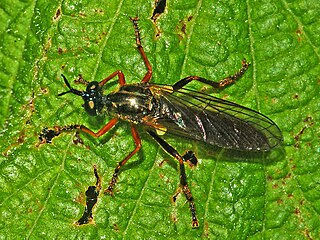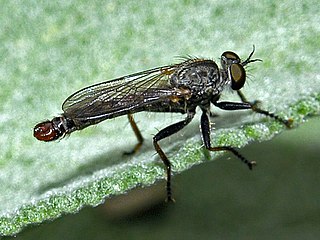
The Asilidae are the robber fly family, also called assassin flies. They are powerfully built, bristly flies with a short, stout proboscis enclosing the sharp, sucking hypopharynx. The name "robber flies" reflects their expert predatory habits; they feed mainly or exclusively on other insects and, as a rule, they wait in ambush and catch their prey in flight.

Eristalis is a large genus of hoverflies, family Syrphidae, in the order Diptera. Several species are known as drone flies because they bear a resemblance to honeybee drones.

Bombylius is a large genus of flies belonging to the family Bombyliidae. They are known as the bee-flies, due to their striking resemblance to bees and bumblebees, and are distributed worldwide. One species of the genus, Bombylius major, is widely distributed throughout the northern hemisphere and is very well known.

Opomyzidae is a family of acalyptrate Diptera. They are generally small, slender, yellow, brown or black coloured flies. The larval food plants are grasses, including cereal crops, the adults are mainly found in open habitats. Some species being agricultural pests.

Villa is a genus of flies belonging to the bee-fly family (Bombyliidae). They range in size from 5 to 17 millimetres, and have typically rounded heads. The males of some species have a brilliant mat of silvery patagial scales. About 270 Villa species are found on all continents except Antarctica. They can be distinguished from similar genera (Hemipenthes) by their wing venation.

Dasypogoninae is a subfamily of robber flies in the family Asilidae. There are more than 60 genera and 520 described species in Dasypogoninae.

Myopa is a genus of flies from the family Conopidae.

Laphria is a genus described by Johann Wilhelm Meigen in 1803, belonging to the family Asilidae, subfamily Laphriinae. Members of this genus are known as bee-like robber flies. This genus has a Holarctic distribution, occurring in Europe, Asia, and North America. They prey on a variety of insects, including other robber flies, bees, wasps and beetles. Like other asilids, they use their proboscis to penetrate the body of their prey and inject enzymes which dissolve the tissues.

Dioctria is a genus of robber fly classified in the subfamily Dasypogoninae in the family Asilidae. Together with the genus Bohartia, Dicolonus, Echthodopa, Eudioctria and Metadioctria it forms the tribe Dioctriini.

Laphriinae is a subfamily of robber flies in the family Asilidae. There are more than 110 genera and 1,000 described species in Laphriinae. Larvae of the genus Hyperechia are known to grow inside the cells of Xylocopa bees, feeding on their larvae.

Cerdistus is a genus of robber flies in the subfamily Asilinae.
Heteropogon is a genus of robber flies in the family Asilidae. There are at least 60 described species in Heteropogon.

Neoitamus is a genus of robber flies in the family Asilidae. There are at least 60 described species in Neoitamus.
Lamyra is a genus of robber flies in the family Asilidae. There are at least 30 described species in Lamyra.
Andrenosoma is a genus of robber flies in the family Asilidae. There are at least 70 described species in Andrenosoma.
Andrenosoma fulvicaudum is a species of robber fly in the family Asilidae. It was first formally named as Laphria fulvicauda by Thomas Say in 1823. The type specimen was from Missouri, but was lost.

Choerades marginata is a species of robber fly found in Europe.

Hyperechia is a genus of robber flies in the family Asilidae. They appear large, stout and with legs covered in bristles and appear like carpenter bees in the genus Xylocopa and the resemblance is considered as a case of aggressive mimicry, providing protection from predators. The larvae of the fly feed on the larvae of Xylocopa within their cavity nests in wood. They are mainly found in the African and Madagascan region with about 15 species and two species in Asia.
Total of 245 species either found or highly expected to be found in New York.















